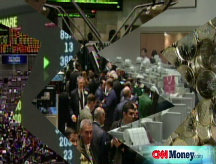Consumers get their bailout...sort of
The $800 billion plan to get banks to make more loans may work but it won't help struggling homeowners. And some worry that more debt is the wrong solution.
NEW YORK (CNNMoney.com) -- The government's latest entry in the alphabet soup cooked up to solve the credit crunch is here. Ladies and gentlemen, behold the TALF!
The TALF, or Term Asset-Backed Securities Loan Facility, is not to be confused with TARP, TAF, TSLF, PDCF or EESA. But all kidding aside, the TALF does differ in one major way from the other initiatives from the Treasury Department and Federal Reserve: this might finally help consumers.
Maybe.
The Fed announced the creation of the TALF Tuesday morning as a way to support owners of securities backed by credit card debt, student loans, auto loans and small business loans.
The Federal Reserve Bank of New York will lend up to $200 billion to holders of this debt, and the Treasury Department is kicking in $20 billion in funding from the $700 billion available through the bank bailout plan to back the program.
This news, combined with a $600 billion initiative also announced by the Fed Tuesday to buy up mortgage-backed securities held by financing giants Fannie Mae (FNM, Fortune 500) and Freddie Mac (FRE, Fortune 500), represent the first major attempt by the government to help consumers as opposed to just doling out more money to banks.
"I am cautiously optimistic this will work," said Chris Probyn, chief economist with State Street Global Advisors in Boston. "The government has subtly reversed course. The original idea of the bailout was to remove toxic assets from the balance sheets of banks. That was subsequently abandoned but they are getting back to it. That's a good thing."
Probyn said that since lenders have increasingly relied on the proceeds from the sale of packages of consumer loans to fund new loans, it has been increasingly difficult to make new loans to people who need them to buy a car, help pay for college or start a small business since the demand for the securities has dried up.
"This could help keep money flowing to consumers and small businesses. People were unable to make more loans because they couldn't sell off existing ones to investors. Nobody wanted them," Probyn said.
Still, it's going to take time before this program kicks in - the government said the $200 billion pegged to help increase consumer lending won't really kick in until February. So it's tough to imagine how the currently bleak forecasts for the holiday shopping season will improve because of this new plan.
"Whenever you throw $800 billion at a problem, you will have some positive reaction. But this won't work exactly the way the Fed and others in Washington will want it to work," said John Norris, an economist and managing director with Oakworth Capital, a private bank based in Birmingham, Ala.
Nonetheless, another economist praised the two new programs and said that more probably will be done to further help consumers.
"The contagion from mortgages has worked its way into other areas such as auto loans and credit cards. So this addresses that," said Ray Stone, economist with Stone & McCarthy Research Associates in Princeton, N.J. "My impression is this may not be the end of the road either, but just a first attempt."
Stone added that anything that can be done to help consumers get access to credit again would be beneficial for the broader economy.
But this does nothing to solve the biggest cause of the current malaise: declining home prices and the rash of foreclosures.
"This doesn't go after the main problem, which is all the bad assets stuck on banks' balance sheets," said Norris.
Still, Stone said the government's latest moves are a step in the right direction, and that more probably needs to be done to really help consumers - despite the obvious strain this will put on the already burdened balance sheet of the Fed.
Stone pointed out that before Lehman Brothers collapsed in mid-September, the Fed had less than $1 trillion on its balance sheet. As a result of Tuesday's new initiatives, he estimated that the Fed's balance sheet will eventually balloon to more than $3.5 trillion.
"If I were a policy maker, I'd be reluctant to do every one of these new things. But these are remarkable times," he said.
However, Norris wasn't sure that the solution to this credit crisis is making more credit available. Sure, it's a problem that there are some credit-worthy borrowers unable to get the loans they need.
But he's worried that the government is throwing so much money at the credit crunch that it could just create a repeat scenario of the current crisis in the future. In other words, now may be the time for consumers to pay down existing debt before worrying about asking for more.
"As a whole, the consumer is tapped out. So while the government may want banks to start lending again, the better the question is to whom?" Norris said. "Does Washington really want banks to go out and start making more problem loans just to have this same problem again in five years?" ![]()




